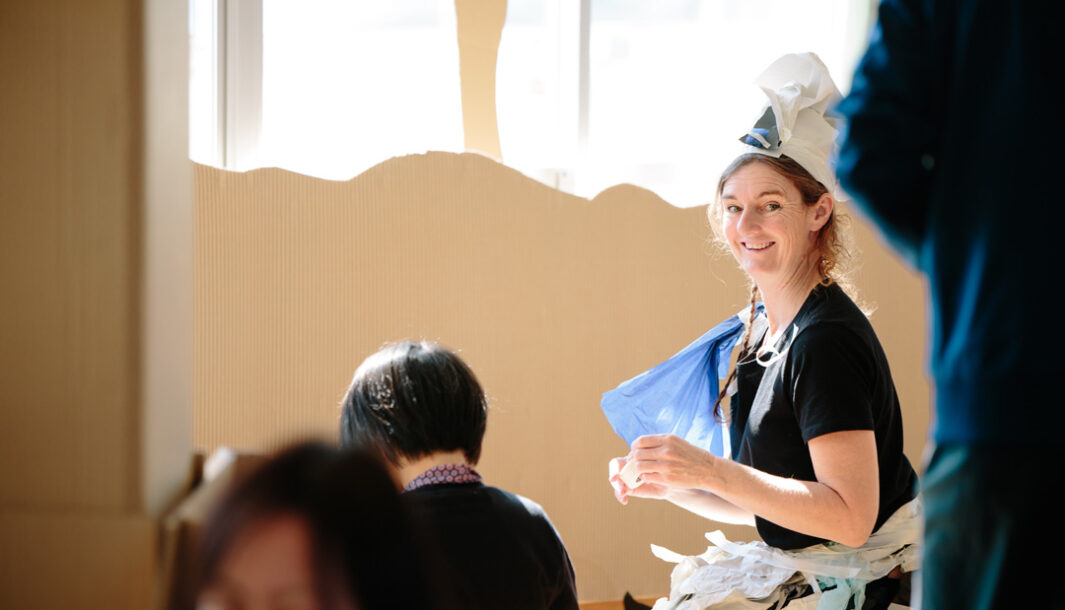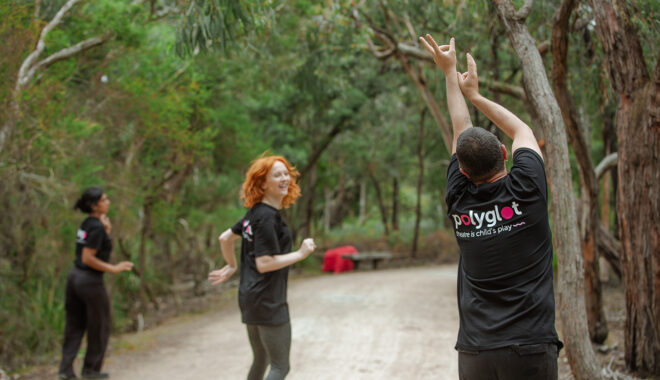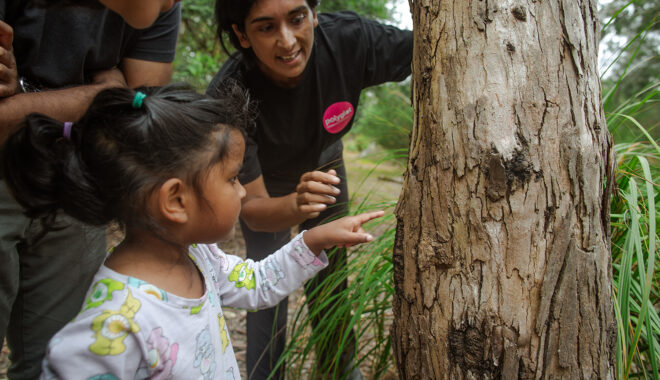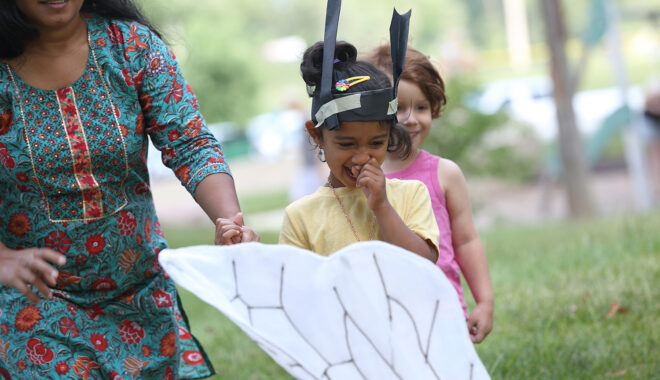20 Aug 2018
“A powerful and wonderful experience”

Written by Stefanie Robinson, Polyglot Theatre artist, with support from Dean Lombard
It’s Wednesday 28 February, 2018. I’m on a bus with Polyglot Theatre, NPO Acchi Cocchi and a collection of guests, all heading towards Hotel Kanyo and Minamisanriku.
This is my fourth visit to this town and the first time I have felt nervous about what I would find.
On the first visit, in 2011, we arrived in the dark. It was six months after what is now called the Great East Japan Earthquake. We were there with three Australian puppets to perform at Recovery Market and to run a newspaper puppet workshop with a school that had been relocated to a neighbouring town after being swept away by the 12-meter wave that destroyed Minamisanriku.
Daylight turned the media images into reality: debris piled up to three storeys high in rows according to type (cars, houses, other)… fragments of people’s lives embedded in the mud…
By our second visit in 2013, the landscape had been mostly cleared of the debris piles, and lay bare. We worked with students from three schools who built their dream homes out of cardboard and paper, an opportunity to imagine and dream and construct. These houses were placed at the entry of We Built This Town: an installation of 3000 boxes, a huge open and free play space. At the public performance this pile of boxes was transformed into a town of mostly shops (plus an Australian embassy), and the children played at buying and selling things: something they hadn’t been able to for real in the last three years. It was light and joyful, games emerging to the sound of laughter.
When we returned in 2015 the rebuilding had begun. But no structures yet: rather, a constant stream of trucks brought soil from the hills to the shore to raise the land up by six meters.
This time we had two weeks, a longer process. We presented a café concert with NPO Arcchi Cocchi at three of the temporary villages, for the elderly community. After the concerts we asked for stories and Bernard Caleo drew them into cartons. From here we choose one story and took it to Irya primary school, asking each grade … ‘Tsugi wa?’ (What happens next?)
Each grade created the next chapter in the story and made puppets and scenery to illustrate it. We put these together into a short performance; NPO Acchi Cocchi created the soundscape, and the following week we presented it to five preschools.
Now, in 2018, I am heading back with Paper Planet: an installation of cardboard trees, a forest that will become filled with paper creations, moulded by the fingers of this wonderful community.
Why am I nervous about arriving this time?
I have witnessed the journey of this town over the last seven years, from the towering piles of cars and rubble in 2011, to the empty landscape in 2013, to the construction zone of 2015. I have experienced the shift from nowhere to eat except the hotel, to the arrival of a temporary shopping centre and some convenience stores, to a few new restaurants by 2015 – but little else had been built and most of the residents still lived in temporary accommodation. Three years later: what would have changed, and what would still be the same? How much work will have been completed? Would people have new homes yet? How would this community be after seven years of rebuilding? How much rebuilding would there still be to do?
The one thing I wasn’t worried about was how we would be received…
We arrive and we bump into the Bayside Arena and begin to build our forest. The NPO Acchi Cocchi team is given a lesson in cardboard tree construction and we get to work to the sound of the bassoon.
A wild storm hits as we head over to visit Tatsuro Sato in the new Board of Education building. Formalities are exchanged and then the stories are told. I hear that most people are out of their temporary accommodation – my first worry removed – and as the week progresses and we drive around to schools I can see the rows of new houses now tucked safely up on the hill.
We have Rosemary from The Australian newspaper with us. In this meeting, her questions reveal the stories and the emotion that sit just beneath the skin. The warmth in the room shifts, it becomes tense and fragile, then the conversation shifts to the visit by Julia Gillard days after the disaster and the important role Australia has played in the recovery, and the mood lightens again. This visit will not be forgotten; it is a symbol of the importance of the physical and the emotional support Australia has given during the recovery. Our returning gives them hope and strength; reminding them that they have not been forgotten. The world still cares. And we, Polyglot, are an integral part of that story.
This shift from light to dark and back again is constant. Our time here traverses these emotions regularly. There is so much beauty here, in the people we meet, in the children we play with, in the ocean and hills; yet the stories that are now embedded in this landscape are huge and dark and full of destruction and loss.
We return through the driving rain and fierce wind to continue to build our forest.
On the Saturday the show opens. The locals trickle in and fill the forest. Families come and build together; on cue Mischa is attacked by small groups of children wanting to up the game. Acchi Cocchi’s live music brings the forest alive.
It is a magical place.
And this continues during the week, as we pack up the forest and take it to each of the five primary schools in the area. Up goes the forest; in come the grade one and two students. Two hours of joyous and delightful play follow, then down comes the forest. Each day we join the classes for lunch. This is such a wonderful opportunity. The curious questions: do you have sharks? What’s the cutest animal in Australia? What is your favourite lunch? (Toasted cheese sandwich for me, hotdogs for him). Songs are offered, laughter, noisy exchanges and smiles, so many smiles.
Each day is completed with a visit to the principals’ office, another opportunity for exchange. Always, the feedback is how wonderful it is to see the children smiling and playing freely – “it’s wonderful that our children are curious” – and how wonderful it is that we have returned – “you must come back.”
We discuss the importance of free play, creativity, expression, the power of art. Our favourite moments were being shown 600-year-old samurai swords, learning calligraphy, and dreaming up the next residency were we would work with all the schools to create a show. “You must come back and work with the whole school.”
I realize that the children we are working with are the age that the preschool children we performed to two-and-a-half years ago would be now… and some remember us being there. I like that there is a direct continuity in our work in this community.
On our last day we visit Tokura Elementary School in their new buildings.
This is the school that we visited in 2011 at their temporary building in a neighbouring town; that in 2015 was sharing a primary school with Irya Elementary School. At that stage they didn’t know if they would continue as a school or be merged with the other primary schools. This is also a school where no-one died in the disaster because two weeks earlier, the then principal changed the emergency evacuation plan from heading to the roof, to heading to the shrine across the road and up the hill from the school.
Their story is in sharp contrast to that of Okawa School, where the emergency plan sent the school into the oncoming wave rather than away from it. We visit the site of the Okawa School, which is now a memorial. When I read the story of this school in a newspaper in Australia, it was a sad story; but standing on the land where this story occurred brings home the reality of what took place – it is deeply moving and harrowing to consider.
It’s stories like these, one on each end of the see-saw – a story of hope, a story of immense sadness – that make up the memories of this place for me.
The full circle I have witnessed with the Tokura elementary school feels significant, a sign that things are beginning to return to normal (or the new normal as we called it in Whittlesea after the Black Saturday bushfires). It also feels strange that I am the only person in the room who has witnessed this journey. The school’s principal is new, no-one from the first trip is with me, all the children from that first visit have moved on and are now in secondary school.
It is such a joy to visit this school and to see a positive outcome, a beautiful new school. Our visit is two days before the anniversary of the earthquake; the children have spent the morning in a memorial service. It’s the only time I have heard the word ‘tsunami’ spoken by the children. It is fresh in the forefront of their minds. These children aren’t old enough to have experienced it themselves, but they have grown up in a post-disaster place, without a town, without playgrounds, and with adults who are recovering from this experience and recreating their homes and community. It once again highlights how important it has been for us to have been there, to bring a play space, moments of free play, joy and creativity. Where the children are in control of their environment and where the adults that surround them get to see the children happy and smiling, playful and joyous.
When I was working in Whittlesea on bushfire recovery (after the Black Saturday fires in 2009) we spoke about the healing edge. Unlike a skin wound, which heals from the outside in, recovery healing spreads outward. One strong person can support and heal another. One child laughing can resonate outwards and bring joy to those around them. In Whittlesea we also spoke about the process of replacing memories of trauma with new ones, happier ones. I hope that each of our visits has played a role in this, sent joy rippling outward into the community, created new stories to tell and exchange.
On looking back over the four visits I can see the difference between the fragility of the first workshop in 2011 to the robustness of play in 2018, between the rawness in the stories we hear, to stories of hope and growth.
It was weird to travel across the new built-up landscape of the town – the completed areas now as high as the pile of rubble I saw in the first visit – and to try and map the old town below. Can you bury the past? Will it protect you in the future?
It was deeply moving to attend the seven-year memorial service. To be invited to share this moment with the community. To feel the room vibrating with emotion and grief. To walk solemnly past the community leaders, in two lines like a guard of honour, on the way out and share this moment with them. It has been an honour to be on this journey with them, however distant we are and however small our contribution feels. Our constant return is important and significant. We are told over and over again how wonderful it is that we return, that they haven’t been forgotten, that the world still remembers them.
It’s not finished yet. The town is still being rebuilt. Will it be done before the money runs out? Will the upcoming Olympics pull the focus – and the workforce, and the money – away from the rebuilding?
The epidermal growth (another image we used in Whittlesea after the bushfires… the new growth sprouted from the burnt tree trunks and beginning to flourish) is establishing itself. It is this growth that I was nervous I wouldn’t see after the last visit. Seven years is a long time to ‘recover’ to rebuild, to be in limbo: it’s exhausting. Yet what we experience when we are there is resilience and generosity – we are welcomed and wonderful connections are made.
Images that now sit beside those of my first visit… education department officer Mr Hatekeyama standing and waving at our departing bus until he was out of sight (there’s so much to be said here, its another story…); Mikako (NPO Acchi Cocchi) sitting in the front of the taxi with the driver finding the next place for us to visit; the new restaurant, the new sake shop, the best fish shop; and a simple buoy, sitting on a table in a newly-reopened restaurant, that had made an incredible journey from the nearby bay to Canada and back, bringing with it a story of hope and endurance, the courage to survive and the momentum to continue after experiencing such harrowing loss.
* * *
There is of course another visit to be made…we aren’t done yet. We need to see the town completed, to acknowledge ten years with them, to step with them into the next ten years, to strength the bonds between us, to let them know we are still here thinking of them…
It surprised me in writing this reflection, the number of times my memories reduced me to tears. This has been a powerful and wonderful experience, of which the words above can barely touch the surface, I notice I have written with a practical ‘what we did’ tone, but this is what I have words for. The experience is resonating deeply in my cells… it will be interesting to see how it expresses itself in my creative practice, the future…
Photography by Ai Ueda
- Polyglot Theatre Admin
Minami Sanriku, Japan







